One of the most important parts of a general manager’s job in the NHL is being able to discern if a team is truly a Stanley Cup contender, and if so, how long that will remain the case. Depending on where they believe their roster to be, there are essentially two types of moves a GM can make; win now moves and rebuilding moves.
While fans may disagree with the front office on which category a trade falls into, both sides generally tend to agree with this dichotomy. Issues between fans and franchises tend to arise when the two sides have vastly different opinions of which bucket a team, or its roster, falls into.
Related: The Greatest Draft in Oilers History: 1979 or 1980?
In most cases, it seems that GMs tend to skew towards believing their teams are better than they are, and that their window is still wide open. Anaheim Ducks fans are intimately familiar with this reality.
Orange County residents have watched in varying levels of dismay as GM Bob Murray has made a series of decisions, including trades and contract extensions, that suggest he has a wildly different understanding of his roster than fans do. And, when he has made trades that fall in line with their evaluations, he has still managed to incite duress by seemingly trading away the wrong players.
Nick Ritchie and Ondrej Kase were far from superstars or even indisputable top-sox forwards, but they were both among the youngest contributing members of the team. Meanwhile, older players like Adam Henrique and Jakob Silfverberg have been given long-term contracts that carry substantial salary cap commitments despite being on the cusp of their 30’s.
While these moves can certainly be justified in a vacuum, they make little to no sense when placed in the context of the Ducks’ season. It has been painfully obvious for a while now that the Anaheim roster lacked the high-end talent needed to contend, and yet Murray has done little to fix that.
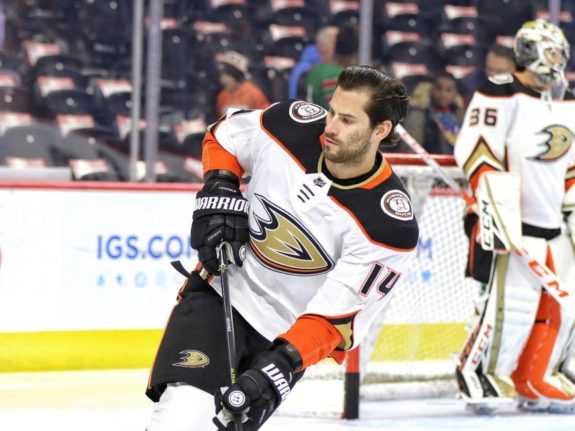
The closest thing Anaheim has to a superstar level talent on the roster is goaltender John Gibson. Having overcome the injury concerns that plagued the early part of his career, Gibson has emerged as a legitimate Vezina Trophy caliber goalie.
Unfortunately, history has shown that it is next to impossible to win a ring with a goalie as the best player on the team, just ask Ryan Miller, Henrik Lundqvist, and Connor Hellebuyck. Anaheim is in desperate need of an infusion of elite, superstar level skaters if they want to have any hope of returning to true contender status. However, that is something far easier said than done.
Finding a Star
There are three ways you can get a star player on your team. First, you can draft them. Despite the uncertainty that comes when you’re trying to evaluate which 17-year-olds will be the most effective 25-year-old, this remains largely the best way to acquire elite talent. Second, you can trade for them. Unfortunately, because acquiring star players is so difficult to do, teams are rarely willing to move on from those players when they finally find them. While this is more than understandable, it also makes trades built around young superstar players far and few between.
The third option is free agency, and while this is certainly a route teams have chosen to go, it is perhaps the most perilous. By the time elite players hit free agency, they are usually at the tail end or beyond their prime years, and looking to cash in. The number of long-term, big-money contracts for players in their late 20’s that aren’t a mistake almost as soon as they’re signed isn’t particularly high. Free agency may very well be the worst possible way to acquire elite talent.
With the Ducks capped out for this season that leaves the draft and making a trade as their remaining paths to elite talent. With the sixth overall pick in this year’s draft, they will certainly have an opportunity to acquire a potential impact player, if not an outright star, to hopefully pair with Trevor Zegras going forward. The Ducks also have the 27th and 36th picks in the draft as well that they can use to take a swing or two on players with some serious potential.
With players like Marco Rossi, Alexander Holtz, Jamie Drysdale, and Lucas Raymond potentially available to Anaheim there is more than enough incentive to stay the course and exercise patience. But given the age of Anaheim’s better players, as well as their current contracts, it seems the Ducks have a foot on both sides of the line and are refusing to commit.
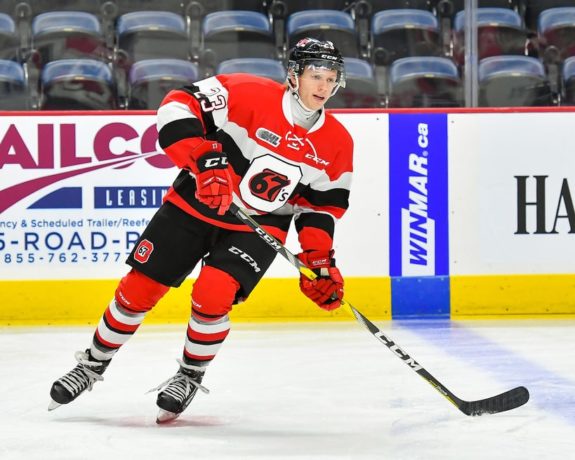
But what if, Murray could simultaneously put the Ducks in a position to compete for the better part of the next decade without sacrificing their ability to win games now? What if Anaheim decided to try and trade for a Hart Trophy level player who wasn’t even 25 yet? What if Anaheim traded for Jack Eichel?
The Rumor Mill Begins to Churn
Frank Seravalli updated TSN’s trade bait list on September 1st and piqued interest around the league when he announced the day before that it would more than likely include a few big names from the Winnipeg Jets. The two names specifically that caught everyone’s attention were wingers Patrik Laine and Nikolaj Ehlers.
While Laine had found himself in trade rumors before, Ehlers had just finished the second year of a seven-year contract that would keep the two-time 60 point scorer under contract until he was 29. All of this was happening before, during, and after teams like the Toronto Maple Leafs, Pittsburgh Penguins, and Edmonton Oilers were prematurely ousted from the league’s return to play bubbles.
Unhappy stars, unhappy owners, and unhappy GMs. The NHL really was back after all. The culmination of these disparate factors seemed to create a perfect storm of context within which front offices around the league could look to make some major moves. There seemed to be no shortage of impact players who could find themselves in new colors come the start of next season.
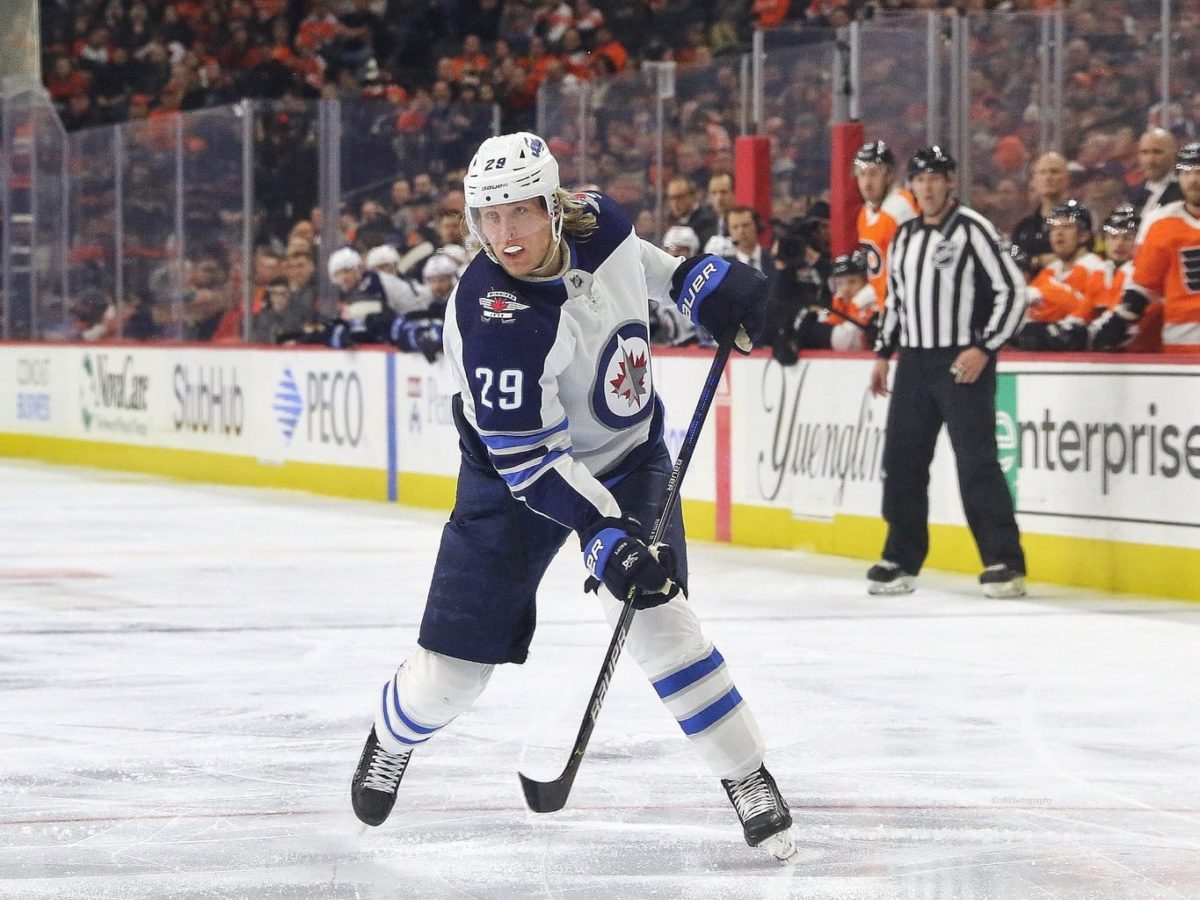
There were a number of notable names on the list as well. As is always the case, the players on that list represented the full range of teams’ positions within the league. Some of them – Matt Murray, James Van Riemsdyk, Marc-Andre Fleury, and Andreas Johnsson for example – represent teams in the middle of a contending window who need to move salary out in order to improve the roster. Other players – such as Kyle Palmieri, Rasmus Ristolainen, or Oliver Ekman-Larsson – are on teams that won’t be contenders next season and are trying to accrue assets accordingly.
The one name that wasn’t on that list, was Buffalo Sabres’ captain Eichel. Now, that may not be surprising given that players of Eichel’s caliber rarely if ever become available. A truly elite level player is so difficult to acquire in the NHL that teams will do just about everything but trade them in an attempt to maximize a superstar’s value in their prime. However, as with all things in 2020, the situation around Eichel was far from normal.
Déjà Vu
Ten weeks before Seravalli’s list came out, the Pegulas named Kevyn Adams the team’s newest general manager after firing Jason Botterill. Coincidentally, less than a month beforehand star player Eichel had made waves by telling reporters he was “fed up with losing” on an end-of-season conference call. A statement that felt eerily similar to Ryan O’Reilly’s admission that he had “lost the love of the game” two years prior that precipitated his trade to the St. Louis Blues.
A few days before Minnesota and Buffalo swapped expiring contracts, a report came out that the Sabres front office might be working under an internal salary cap. Despite his prior insistence to the contrary, there had been rumors that Buffalo was not going to be a cap team even before the COVID-19 pandemic hit and decimated the league’s finances. So while Adams had brought in a notably older player, the move was more than defensible from Buffalo’s perspective.
Eric Staal crucially fills two needs for the Sabres. First, he’s somehow still quite good. Despite not finding his way to Minnesota until he was 32, he still put up really solid numbers. For his tenure in St. Paul, he’s over 50% in Corsi for percentage, goals-for percentage, and expected goals-for percentage according to Natural Stat Trick. As far as more traditional counting numbers go, the big centerman still wins over fifty percent of his draws, he had 173 takeaways to only 135 giveaways, and he managed to rack up 111 goals and 129 assists in 311 games.
Secondly, he’s a player at a position of need for cheap. He’s no longer the elite first-line center he was in his prime to be sure. But he doesn’t have to be since Buffalo already has that in Eichel. What they’ve needed since trading away Ryan O’Reilly was a legitimate second-line center. Not to mention that even when O’Reilly was on the team they were still in desperate need of legitimate scoring depth.
While Jeff Skinner has had both a great year and a not so great year during his tenure in Buffalo, that’s been the case his whole career. The only other forward they have under contract is Kyle Okposo who has scored 57 goals in 4 seasons on the Sabres, never once reaching the 20 goal mark.
Despite Eric Staal still being good at 35, he is in fact, 35. We have seen time and time again that aging curves for professional athletes are non-linear. Some players can continue to be effective for years after their prime, while others can go from borderline elite to borderline AHLer in a single offseason.
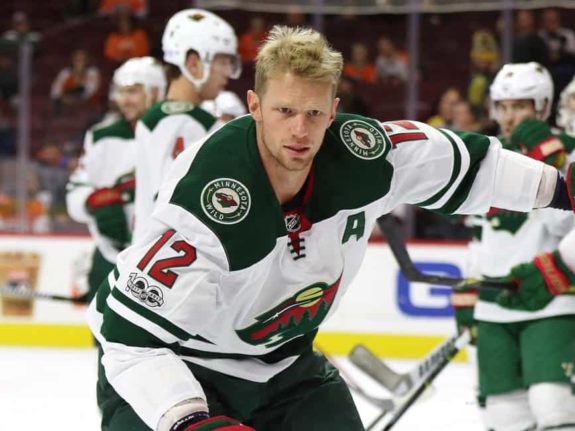
Furthermore, even if Staal is able to play well for the Sabres next season, he will have turned 36 before the season’s presumed start date and become a UFA when it’s over. So while this move is more than defensible for now, it does nothing to address the longterm issues facing Buffalo. That fact, combined with an internal salary cap, isn’t likely to overwhelm the young Buffalo captain with the feeling that his concerns are being addressed.
How Soon is Now?
Surely Rakell could find his way back to 30 goals and 60 points if he were to find himself on the wing of a true number one center. It’s hard not to look at his tenure playing with Corey Perry and Ryan Getzlaf and see that while he may not be able to drive a line on his own, he’s certainly capable of playing with high-end offensive players.
Henrique and, perhaps most importantly, Getzlaf would benefit from settling into new roles as middle-six centers. While the captain’s best days are surely behind him, if Anaheim were to acquire an elite talent, that fact would be far less of an issue.
Both Getzlaf and Henrique would likely be much more successful in splitting the middle-six roles and providing steady minutes, instead of trying to fill the first-line role between the two of them. The rest of the Ducks’ forward crew is not completely devoid of talent, they are just trying to be more than the sum of their parts in a way that is wholly implausible.
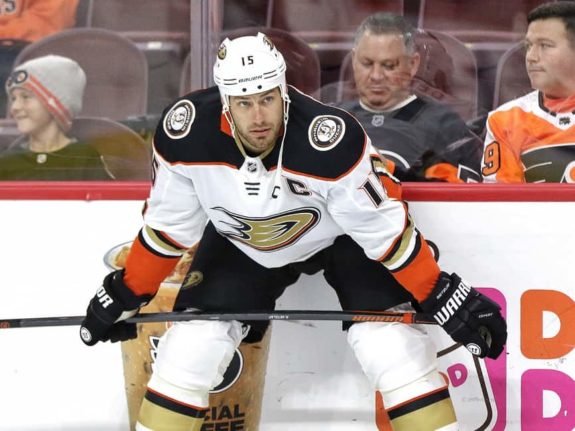
While Anaheim’s defense corp is not as strong as it has been in the past, the fact remains that the team could be far worse off than they are. Hampus Lindholm, Josh Manson, and Cam Fowler remain a solid group to build around, and there is enough young talent in the system to at least remain optimistic about the unit’s potential to improve.
And, if nothing else, this is a unit that is still backstopped by John Gibson, who may very well be one of the five best goalkeepers in the league. He just hasn’t had a whole lot of support recently. Injecting some much-needed offense into the roster could prove to be just the boost needed for the rest of this roster to thrive.
A Star in the Hand is Worth Two in the Draft
As it stands now, the Ducks will go into the 2020 NHL Entry Draft with three picks in the top 40, a promising young prospect in Zegras, and a handful of assets that they could move for more draft capital or prospects. If Anaheim is truly ready to start the rebuild that’s required, then they need to go into the draft with the mindset of moving on from their veterans. given the abnormal events that have led to a Stanley Cup Final in the middle of September, there are more than a few teams with high draft picks who are in win-now mode.
While Zegras has the kind of talent and upside that can elevate a middling prospect pool into relevancy, the fact remains there are more potential NHLers than potential difference-makers in the Anaheim pipeline right now. This year’s draft will be a major factor in what the next decade-plus will look like in Southern California, for good or bad.
Unfortunately, even the best teams miss on draft picks. Even when there’s a consensus number one pick, things can still go astray. So, Murray needs to ask himself exactly how good does he think Zegras and whoever he drafts this October can be, and unless the answer is “elite”, he’s got some soul-searching to do.
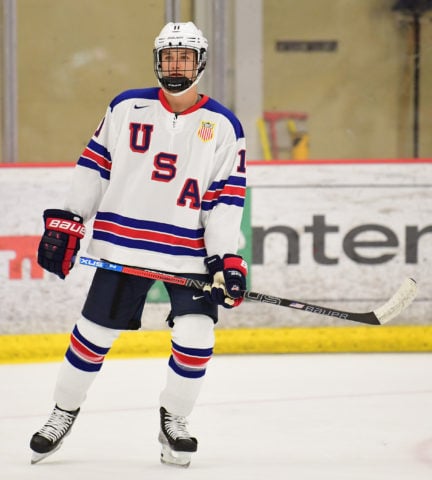
Eichel will turn 24 on October 28th. While he is already on a significant contract that will see him make $10 million a year for the next six years, he is just now entering his prime. If there were ever a chance for a GM to push all their chips into the middle of the table and go for it, Eichel might be it.
He’s a proven star in this league who still has his best years ahead of him and is under contract for the duration of his 20s. If the Pegulas are going to continue to force their front office to be hyper-aware of their paid salary, trading an expensive player for a haul of young, cost-controlled assets might be their best path to relevancy.
Dylan Cozens is already beginning to make a name for himself as one of the best prospects in the NHL. The young centerman has a combination of size and skill that should make him an impactful player for years to come. Buffalo also has the eighth and 38th overall picks in this year’s entry draft, putting them in a prime position to add both depth and upside to their prospect pool. Imagine how much better their future would look if they were to add Zegras and three more picks inside the top 40 to it.
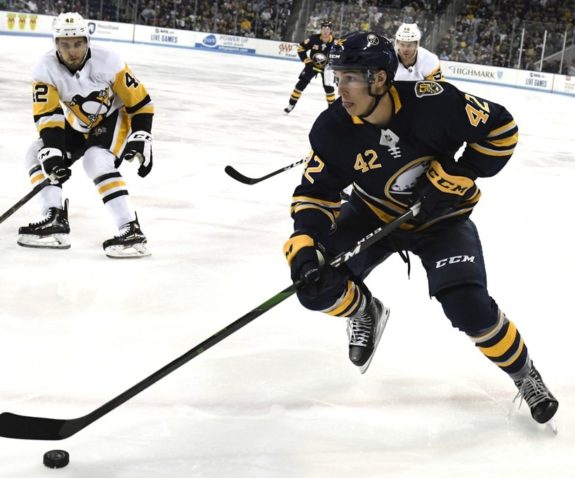
Any trade for Eichel would have to absolutely blow the doors off the building in Buffalo. Having just made another change at the top of the organization, if they were to part ways with a talent of Eichel’s caliber they would have to be able to show their fanbase it was a clear improvement. Any offer starts with Zegras and both first-round draft picks for this year. On top of that Anaheim would need to find other ways to make parting with Eichel worthwhile for the Sabres.
While trading away three top-40 picks and the team’s best forward prospect since Ryan Getzlaf would be a serious pill to swallow, Anaheim is uniquely positioned to make this trade. Murray could piece together a package of players to go with the aforementioned prospect and picks, that would carry a significant cap hit but minimal cost. The combination of high-value picks, elite prospects, and the type of contracts that can help Buffalo stay above the salary floor but under their internal salary cap could just be enough to get the trade done.
Ryan Kesler’s Final Act
The Toronto Maple Leafs have made no secret of their willingness to spend money, even spending money so they can afford to spend more money. While the NHL does not have a true luxury tax system, the Maple Leafs have managed to weaponize their wealth and long-term injured reserve (LTIR) in order to keep together one of the league’s best young forward cores in the league. In an article from May, Seravalli looks around the league to see if there are any contracts that Toronto could look to acquire in order to continue to do so. One of the contracts he mentions is Kesler’s.
One of the things that make the Kesler contract so intriguing is how cheap it is. Despite carrying a cap hit of $6.675 million for another two years, the contract itself is insured for 80% of the salary. So while it will see Kesler make a little over $13 million in the next two years, only $2.67 million of that will be paid by the team.
The Ducks also carry two other contracts on their books that see the actual salary come in under their cap hit. Erik Gudbranson has one year left on a deal that counts for $4 million against the salary cap but will only make $3 million in actual salary. Likewise, David Backes’s $3 million has a cap hit of $4.5 million but also makes just $3 million in salary this season.

Therefore, Anaheim could put together a package of picks and prospects to pair with Kesler, Gudbranson, and Backes’s contracts that would carry a cumulative cap hit of $15.175 million. However, the total cost of those contracts would only require Buffalo to pay out $7.335 million in actual dollars.
For a team working under an internal salary cap, that could be incredibly appealing. Anaheim could even offer to take on Ristolainen and his $5.54 million a year deal, in both cap hit and salary, that lasts until the summer of 2022 in order to offset Buffalo’s salary expenses even further.
Now, it should be noted, that this deal could also get completely flipped around and still work. While Anaheim lacks a player of Eichel’s caliber, which almost certainly insures that Cozens is beyond reach, the eighth overall pick and the rest of Buffalo’s prospect pool could certainly be in play. Players like Henrique, Manson, Rakell, and Silfverberg would all be able to provide vital depth and talent to a Buffalo roster seeking to contend. And Anaheim would certainly be more than happy to take a draft pick or three off of Kevyn Adams’ hands in order to speed up its own rebuild.

Unfortunately for Buffalo, they are currently at the bottom of what might be the best division in the NHL. With Tampa Bay, Toronto, and Boston more than likely to continue dominating the league, and Florida and Montreal remaining wild cards, the Sabres might be wise to kick the proverbial can down the metaphorical road.
All of those rosters are going to naturally atrophy as the years progress and players either age out of relevance or into bigger contracts. The idea of moving on from someone of Eichel’s caliber so early in their career would surely be a tough pill to swallow. But by building around Zegras and Cozens down the middle, Adams could put his team in a position to be among the very best teams in the league for a decade-plus.
Meanwhile, Murray will have finally completed that retool on the fly Anaheim fans have been hearing about for the last few years. Not only would the Ducks be in a prime position to compete for years to come, but they would also have brought a bonafide star to Southern California with his best years still to come. Throw in the fact that Eichel may very well be the most high-profile American born player to play in Southern California, and Anaheim could have a lot to be excited about.
Related: The Real NHL Expansion Markets Are in Europe
Is the price high? Absolutely. Is there a significant risk inherent to trading away multiple first-round picks for a single player? Unequivocally. But the one and only time Anaheim won a Stanley Cup, the GM went out and added an elite player to an otherwise solid roster in order to get it over the hill. Murray has never shown that same type of fearlessness in his time in charge of the Ducks. But if there was ever a time to prove to everyone that he was capable of making the big, bold play, he might never get as good an opportunity like this again.